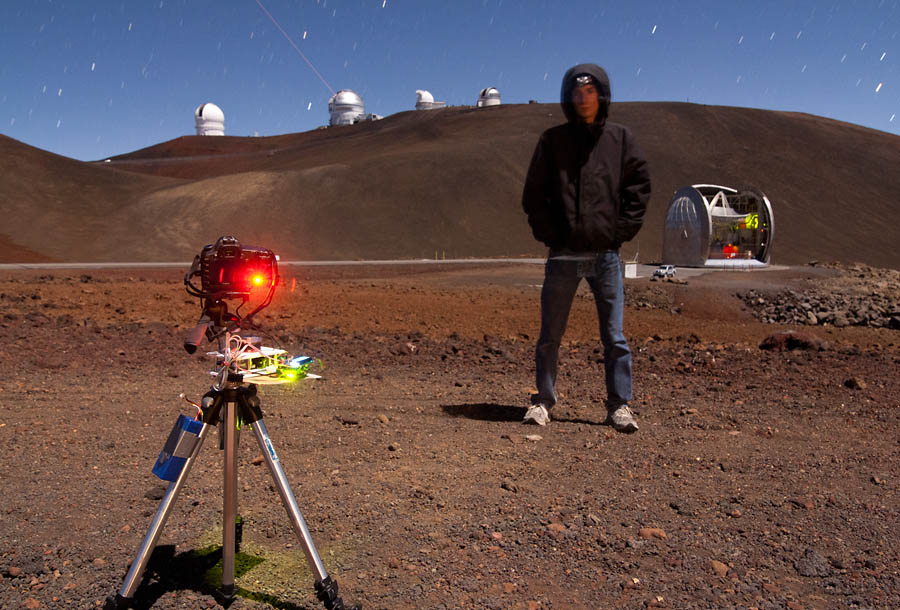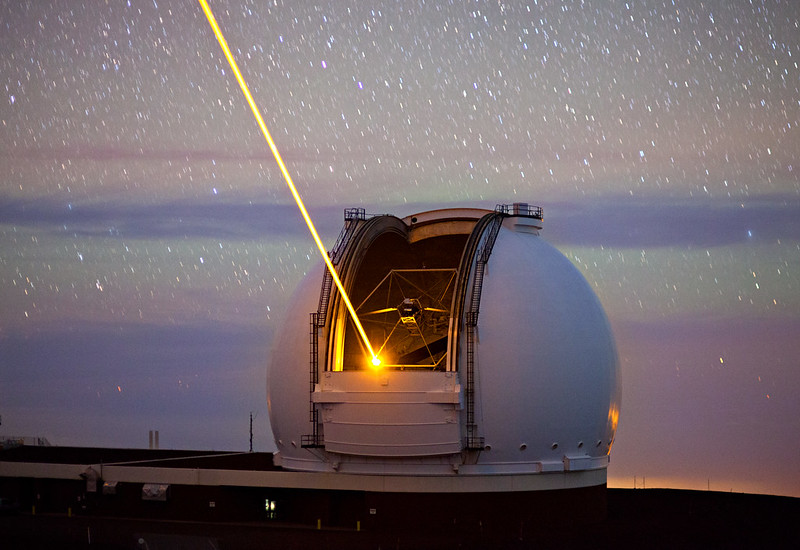Questions and Answers about Mauna Kea Heavens:
September 2013
Jump to...
Why did you make this video?
What's the deal with the lasers? You Photoshopped those in, right?
How did you know what to shoot?
Describe a typical night of filming.
What improvements would you like to see on Mauna Kea?
What gear did you use? What post-processing did you do?
This page is ridiculous. You clearly have no life.
- Why did you make this video?
- Because timelapse of the night skies is awesome. Telescopes are awesome, too. Throw in some 1-ft-wide lasers, and then it's even better.
- What's the deal with the lasers, anyway? You Photoshopped those in, right?
- Actually, the lasers are real. They're used for adaptive optics. Just as waves of heat coming off pavement
blur out the detail in faraway objects, winds in the atmosphere blur out fine detail in the stars/galaxies/whatever is being observed. This is the reason that stars twinkle. The
laser is used to track this atmospheric turbulence, and one of the mirrors in the telescope bends hundreds of times per second in order to cancel out the blurring. Adaptive optics is
pretty cool, and was the topic of my first 8-month research project in graduate school.
- A typical laser pointer that you might use to point at stuff/exercise your cat is about 5 mW. That's five one-thousandths of a watt. Not a whole lot of power. And yet it's enough to blind airplane pilots. The lasers on the telescopes are in the range of 15-40 watts. The FAA calls a no-fly zone over the area when a laser is in use, and two people have to stand around outside in the freezing temperatures and watch for airplanes. Each of them has a kill switch to turn off the laser in case an airplane comes near. Additionally, the telescope has to send its target list to Space Command ahead of time. Space Command then tells them not to use the laser at specific times, ostensibly to avoid blinding spy satellites. However, you could calculate the spy satellite orbits if you knew where they were at specific times, so Space Command also tells the telescope to not use the laser at random times when no satellites are overhead.
- How did you know when and what to shoot?
- Basically, I watched the telescope schedules. Every observatory is in use every night, but I generally tried to catch lasers. Keck I and II, Gemini, and Subaru are the four telescopes
that currently have lasers. On the Keck and Gemini
schedules, "LGS" (Laser Guide Star) indicates that a laser will be used. On the Subaru schedule, "AO188" (188-element
adaptive optics system) indicates that they'll probably use the laser. I got sunrise, sunset, moonrise, moonset, moon phase, etc. information from a great freeware program called
The Photographer's Ephemeris, which shows this information and more on Google Maps imagery. Weather information can be
retrieved from the astronomy-specific Mauna Kea Weather Center site.
- Describe a typical night of filming.
- I filmed when the telescopes were doing interesting things (LASERS!), the weather was hopeful, the moon phase was small, and people to drive with were available. This combination of
requirements often dictated that I go up on weeknights. I was unwilling to take time off work, so on multiple occasions I worked until the evening, rushed home to grab gear, drove up the
mountain, shot timelapse all night, arrived home around sunrise, slept 1-2 hours, and then headed into work for the next day. Coffee, I love you.
- A typical scene took about 5 hours to film (300 1-minute exposures), and I had two cameras, so I could generally film two scenes per night. I had one chance to get it right, and mistakes were far more likely at 14,000 ft (4200 m). The temperatures were generally around freezing, and there often were high winds. We typically spent the first several hours per night driving around and setting up cameras. For the middle of the night, when the cameras were running, we typically took refuge inside JCMT. I know the JCMT operators from my observing trips, and they extremely generously allowed me come into the telescope to warm up. After three or four hours of freezing in the howling winds outside, this was basically the best thing ever.
- Essentially everyone suffers from altitude sickness. Children, obese, and elderly are discouraged from going to the summit at all. All the observatories have oxygen bottles. It's not uncommon for tourists to step out of their vehicles and immediately pass out. Going from sea level to 14,000 ft in the span of a couple hours will do that to you. It's one thing to go to the summit for half an hour to watch sunset, which is what the tourists do, but it's quite another to stay up there for 7 hours while massively sleep-deprived and freezing cold. We stopped at the visitor center (at an altitude of 9,200 ft) for an hour while driving up in order to acclimate. This certainly helped, but generally by halfway through the night, everyone would have headaches. I'm in good shape (and have backpacked to higher locations than Mauna Kea), but I've had my vision fade out, have lost my balance, and/or have needed to stop to catch my breath while hiking around at night. When observing, everyone is required to spend a full day at the village in order to acclimate before going to the summit. This, coupled with (semi-)sufficient sleep and a general lack of strenuous physical activity, greatly reduces the occurrence of altitude sickness.
- What improvements would you like to see on Mauna Kea?
- MOAR LASERS. Every telescope should have a laser, regardless of whether or not it would actually have any scientific benefit. The dishes of the Submillimeter Array in particular each need a laser. I think there will be widespread support within the photographic community for this upgrade, airplanes and satellites be damned.
- ACTUALLY ENFORCE THE "NO HEADLIGHTS" RULE. There are signs on the summit telling vehicles to turn off their headlights and only use fog/running lights in order to avoid blasting light into the open observatories. The speed limit on the summit is 5 mph, so this isn't unsafe. Naturally, tourists drive around and flood the whole area with their high-beams, screwing over the telescopes, creating a hazard to other drivers, and (worst of all) ruining my photos. Offending cars should be paintballed and their drivers tazed. See below for what happens when someone commits the crime against humanity that is driving around with headlights on.

Four sequential frames from a timelapse sequence. People driving around the summit with
their headlights on make baby Jesus cry.
How Nathan Yan suggested I fix the headlight problem. - What gear did you use? What post-processing did you do?
- I shot the montage on a Canon 5D Mk. II and an old-as-dinosaurs Rebel XT. I'm trying to run the XT into the ground (the shutter is rated for 50,000 photos and I've taken about 70,000),
but it refuses to die, so I keep using it. When the shutter dies, I plan to fill the mirror box with dirt, plant a cactus in it, and then buy an actually decent second body. Anyway, the
5D II was usually paired with either a Rokinon 24mm f/1.4 or a Tokina 16-28mm f/2.8, and the Rebel XT was usually used with a Tokina 11-16mm f/2.8. Additionally, a Rokinon 14mm f/2.8,
Nikon 14-24mm f/2.8, Bower 35mm f/1.4, and a Sigma 50mm f/1.4 were each used for one scene. I also used a
home-built rotary table to create camera motion in some of the scenes. My timelapse dolly lives
in a closet in California, so it wasn't used in this montage.

"Oh man it's cold! I sure hope I'm not standing in my timelapse. Let's see if I can stand still for two minutes while the camera exposes. Ragghh, so cold! Nope... I guess I couldn't stand still. Whatever, close enough, I'm going back to the warmth of the telescope now."- I shot all my images in RAW format (yep, that's a lot of space). Images were edited in Adobe Camera Raw (part of the Photoshop suite). To add adjustable crops/white balance/etc., I ran the images through a moderately buggy program called LRTimelapse. Images were resized to 1080p in Photoshop and saved as jpgs. A few sequences were run through Virtual Dub with MSU Deflicker (for deflickering) or After Effects (for stabilization). The final video was edited together in Adobe Premiere.
- This page is ridiculous. You clearly have no life.
- That's not even a question. And I would like to point out that you have just read to the bottom of an entire webpage answering random questions about a less-than-3-minute timelapse video.
